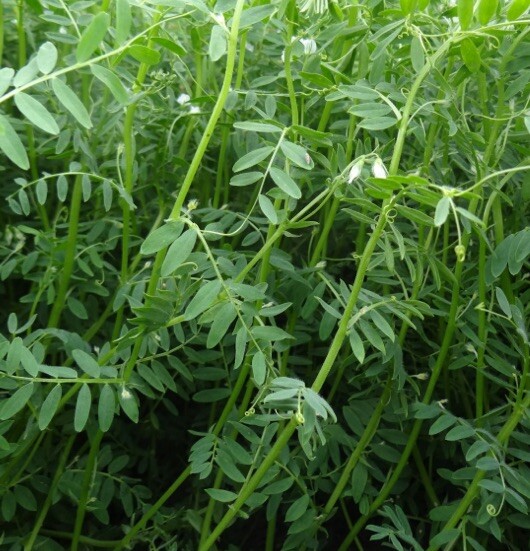Brown manuring your pulse crop - is it an option this year?
The wet season and disease issues means many pulse growers may be contemplating what to do next with their crops. This blog talks about brown or green manuring of pulses, for increased fertility and weed management.

Key messages
- Pulse crops are under pressure due to current wet conditions and disease
- Brown or green manuring pulse crops may be an option this spring
- Brown or green manuring can increase soil nitrogen, provide weed control options, help conserve moisture & improve soil structure and improve subsequent crop gross margins
Perhaps trafficability has created difficulties with fungicide application and disease management has become problematic in your pulse crop. Or maybe specific weed issues have recently come into focus?
If this has you contemplating what to do next with your pulse crop, it might be worth considering brown or green manuring.
Brown/green manuring - what is it?
Brown or green manuring return plant material to the soil with the aim of increasing soil organic matter, improving soil fertility or reducing weeds. Pulses tend to be preferred because they add more nitrogen, compared to oilseeds and cereals.
Brown manuring is considered the ‘no-till’ version of green manuring and uses a non-selective herbicide to desiccate the crop and kill any weeds present at flowering. Residues are left standing, which helps retain soil cover, preserve soil structure, and increase soil organic matter. A variation is mulching, where the crop/pasture is cut and residue left on the soil surface, reducing soil moisture loss through evaporation. Because of the smaller pieces and increased soil contact, mulched residues tend to break down more quickly than standing residue.
In comparison, green manuring physically incorporates the green plant residue into soil using cultivation.
When to use it
Brown manuring could be an option this year for pulse crops that have been impacted by disease or waterlogging or where weeds have become problematic (especially herbicide resistant ones). It could also be an option where farmers are looking to strategically boost soil nitrogen ahead of the next crop, especially given the current high fertiliser prices.
Where weed control is a significant issue, brown manuring can deliver strategic herbicide knockdown and allow the rotation of herbicide chemical groups. Brown manuring for weed control should coincide with the weed seed set of the main target species (i.e. ryegrass, wild oats) and a second knockdown herbicide may be needed to kill surviving weeds, particularly where bulky crops limit herbicide penetration into the lower canopy. When brown manuring for weed control, pulses should be desiccated at/before the milky dough stage of the target weeds, which is usually before the crop’s peak dry matter production (the amount of nitrogen fixed by the crop at this stage will be less than if dessication is timed for peak crop biomass).
When boosting soil nitrogen or organic matter is a key driver, the crop should be brown manured close to its maximum dry matter. Between 15-25 kg of nitrogen can be fixed per tonne of shoot dry matter (assuming effective concentrations of rhizobia and high soil mineral nitrogen doesn’t inhibit nitrogen fixation), so the higher the dry matter of the pulse or legume, the higher the amount of nitrogen fixed. A later brown manuring will increase the soil nitrogen benefits but may not match weed control objectives.
There are differences in nitrogen fixation rates across pulse/legume species. In 2013, a Riverine Plains and CSIRO crop sequencing trial at Yarrawonga showed that vetch produced the highest total plant fixed nitrogen (141kg N/ha), followed by arrowleaf clover (138kg N/ha), faba beans (129kg N/ha) and sub-clover (118kg N/ha), while field peas (86kg N/ha) and chickpeas (50kg N/ha) produced significantly less. A key message here is that growing conditions and the species sown may influence nitrogen fixation rates and affect the crop's potential to boost soil nitrogen in subsequent crops .
When brown-manuring, always follow chemical label rates and instructions.
The economics
A pulse crop can provide advantages for subsequent wheat yields in the first and second year, compared to wheat on wheat. This holds regardless of whether legume/pulse crops are brown manured or harvested.
In the 2013 Riverine Plains and CSIRO trial at Yarrawonga South, it was found that while brown manuring can have negative gross margins in the first year, the reduction in weed control costs and nitrogen input costs can pay off through the increased profitability of subsequent wheat crops, particularly if resistant weeds are an issue. As such, it helps to consider the value of the pulse in the context of the whole rotation, not just in the year of the brown manuring.
Seek further advice from your agronomist or advisor if brown manuring might be an option for you this season.
References & further reading
- Carbon farming - green & brown manuring.
- Break crops - impacts on income, nitrogen & weeds
- Brown manuring pulses on acidic soils in southern NSW – is it worth it?
- Managing brown manure crops in southern NSW factsheet (GRDC)
Author
NEWS
Keep up to date with the latest news from across the Riverine Plains.
-
Livestock
-
People
-
Grains
-
Sustainability

